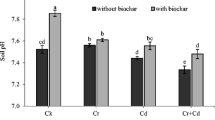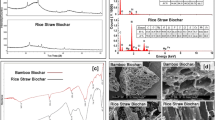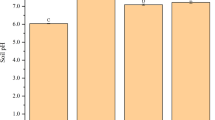Abstract
Accumulation of heavy metals in unconsolidated soils can prove toxic to proximal environments, if measures are not taken to stabilize soils. One way to minimize the toxicity of metals in soils is the use of materials capable of immobilizing these contaminants by sorption. Biochar (BC) can retain large amounts of heavy metals due to, among other characteristics, its large surface area. In the current experiment, sugarcane-straw-derived biochar, produced at 700 °C, was applied to a heavy-metal-contaminated mine soil at 1.5, 3.0, and 5.0 % (w/w). Jack bean and Mucuna aterrima were grown in pots containing a mine contaminated soil and soil mixed with BC. Pore water was sampled to assess the effects of biochar on zinc solubility, while soils were analyzed by DTPA extraction to confirm available metal concentrations. The application of BC decreased the available concentrations of Cd, Pb, and Zn in the mine contaminated soil leading to a consistent reduction in the concentration of Zn in the pore water. Amendment with BC reduced plant uptake of Cd, Pb, and Zn with the jack bean uptaking higher amounts of Cd and Pb than M. aterrima. This study indicates that biochar application during mine soil remediation could reduce plant concentrations of heavy metals. Coupled with this, symptoms of heavy metal toxicity were absent only in plants growing in pots amended with biochar. The reduction in metal bioavailability and other modifications to the substrate induced by the application of biochar may be beneficial to the establishment of a green cover on top of mine soil to aid remediation and reduce risks.



Similar content being viewed by others
References
Ahmad M, Rajapaksha AU, Lim JE, Zhang M, Bolan N, Mohan D, Vithanage M, Lee SL, Ok YS (2014) Biochar as a sorbent for contaminant management in soil and water: a review. Chemosphere 99:19–33
Ambrosano EJ, Trivelin PCO, Cantarella H, Ambrosano GMB, Muraoka T (2003) Nitrogen mineralization in soils amended with sunnhemp, velvet bean and common bean residues. Sci Agric (Piracicaba, Braz) 60:133–137
Bataglia OC, Furlani AMC, Teixeira JPF, Furlani PR, Gallo JR (1983) M étodos de an álise química de plantas. Instituto Agronômico, Campinas (in Portuguese)
Beesley L, Moreno-Jim enez E, Fellet G, Carrijo L, Sizmur T (2015) Biochar and heavy metals. In: Lehmann J, Joseph S (eds) Biochar for environmental management: science and technology. Earthscan, London
Bian R, Joseph S, Cui L, Pan G, Li L, Liu X, Zhang A, Rutlidge H, Wong S, Chia C, Marjo C, Gong B, Munroe P, Donne S (2014) A three-year experiment confirms continuous immobilization of cadmium and lead in contaminated paddy field with biochar amendment. J Hazard Mater 272:121–128
Brennan A, Jimenez EM, Puschenreiter M, Alburquerque JA, Switzer C (2014) Effects of biochar amendment on root traits and contaminant availability of maize plants in a copper and arsenic impacted soil. Plant Soil 379:351–360
Butnan S, Deenik JL, Toomsan B, Antal MJ, Vityakona P (2015) Biochar characteristics and application rates affecting corn growth and properties of soils contrasting in texture and mineralogy. Geoderma 237–238:105–116
Camargo OA, Moniz AC, Jorge JA, Valadares JMAS (2009) Chemical and physical analysis methods of soil of agronomic institute of Campinas. IAC, Campinas, p 94, in Portuguese
CONAB - Companhia Nacional de Abastecimento (2013) Acompanhamento da safra brasileira: Cana de açúcar, segundo levantamento, agosto/2013. Conab, Brasília, p 19, in Portuguese
Costa CG, Santos GS Jr, Amorim LS, Rosalino LM, Figueiredo LTM, Verdade LM (2013) The effect of pre-harvest fire on the small mammal assemblage in sugarcane fields. Agric Ecosyst Environ 171:85–89
Fang Y, Singh B, Singh BP (2015) Effect of temperature on biochar priming effects and its stability in soils. Soil Biol Biochem 80:136–145
Fellet G, Marchiol L, Delle Vedove GD, Peressotti A (2011) Application of biochar on mine tailings: effects and perspectives for land reclamation. Chemosphere 83:1262–1267
Fellet G, Marmiroli M, Marchiol L (2014) Elements uptake by metal accumulator species grown on mine tailings amended with three types of biochar. Sci Total Environ 468–469:598–608
Ferreira-Leitão V, Gottschalk LMF, Ferrara MA, Nepomuceno AL, Molinari HBC, Bon EPS (2010) Biomass residues in Brazil: availability and potential uses. Waste Biomass Valorization 1:65–76
França DA, Longo KM, Soares Neto TG, Santos JC, Freitas SR, Rudorff BFT, Cortez EV, Anselmo E, Carvalho JA Jr (2012) Pre-harvest sugarcane burning: determination of emission factors through laboratory measurements. Atmosphere 3:164–180
Han Y, Boateng AA, Qi PX, Lima IM, Chang J (2013) Heavy metal and phenol adsorptive properties of biochars from pyrolyzed swithgrass and woody biomass in correlation with surface properties. J Environ Manage 118:196–204
Harvey OR, Herbert BE, Rhue RD, Kuo LJ (2011) Metal interactions at the biochar-water interface: energetics and structure-sorption relationships elucidated by flow adsorption microcalorimetry. Environ Sci Technol 45:5550–5556
Houben D, Evrard L, Sonnet P (2013) Beneficial effects of biochar application to contaminated soils on the bioavailability of Cd, Pb and Zn and the biomass production of rapeseed (Brassica napus L.). Biomass Bioenergy 57:196–204
IUSS Working Group WRB (2014) World Reference Base for Soil Resources 2014. International Soil Classification System for Naming Soils and Creating Legends for Soil Maps. World Soil Resources Reports No. 106. FAO, Rome
Ippolito JA, Spokas KA, Novak JM, Lentz RD, Cantrell KB (2015) Biochar elemental composition and factors influencing nutrient retention. In: Lehmann J, Joseph S (eds) Biochar for envrionmental management: science, technolody and implementation, 2nd edn. Routledge, London, p 137–161
Jiang J, Xu R, Jiang T, Li Z (2012) Immobilization of Cu(II), Pb(II) and Cd(II) by the addition of rice straw derived biochar to a simulated polluted Ultisol. J Hazard Mater 229–230:145–150
Kabata-Pendias A (2011) Trace elements in soils and plants, 4th edn. CRC Press, Boca Raton
Karami N, Clemente R, Moreno-Jiménez E, Lepp NW, Beesley L (2011) Efficiency of green waste compost and biochar soil amendments for reducing lead and copper mobility and uptake to ryegrass. J Hazard Mater 191:41–48
Kim W, Shim T, Kim Y, Hyun S, Ryu C, Park Y, Jung J (2013) Characterization of cadmium removal from aqueous solution by biochar produced from a giant Miscanthus at different pyrolytic temperatures. Bioresour Technol 138:266–270
Kloss S, Zehetner F, Wimmer B, Buecker J, Rempt F, Soja G (2014) Biochar application to temperate soils: effects on soil fertility and crop growth under greenhouse conditions. J Plant Nutr Soil Sci 177:3–15
Lehmann J, Joseph S (2009) Biochar for environmental management: science and technology. Earthscan, London & Sterling
Lu H, Li Z, Fu S, Méndez A, Gascó G, Paz-Ferreiro J (2014) Can biochar and phytoextractors be jointly used for cadmium remediation? Plos One 9, e95218
Lu H, Li Z, Fu S, Méndez A, Gascó G, Paz-Ferreiro J (2015a) Combining phytoextraction and biochar addition improves soil biochemical properties in a soil contaminated with Cd. Chemosphere 119:209–216
Lu H, Li Z, Fu S, Méndez A, Gascó G, Paz-Ferreiro J (2015b) Effect of biochar in cadmium availability and soil biological activity in an Anthrosol following acid rain deposition and aging. Water Air Soil Poll 226:164
Lucchini P, Quilliam RS, de Luca TH, Vamerali T, Jones DL (2014) Does biochar application alter heavy metal dynamics in agricultural soil? Agric Ecosyst Environ 184:149–157
Machida M, Mochimaru T, Tatsumoto H (2006) Lead (II) adsorption onto the graphene layer of carbonaceous materials in aqueous solutions. Carbon 44:2681–2688
Melo LCA, Coscione AR, Abreu CA, Puga AP, Camargo OA (2013) Influence of pyrolysis temperature on cadmium and zinc sorption capacity of sugar cane straw derived biochar. Bioresources 8:4992–5002
Mendez A, Paz-Ferreiro J, Araujo F, Gasco G (2014) Biochar from pyrolysis of deinking paper sludge and its use in the treatment of a Ni polluted soil. J Anal Appl Pyrolysis 107:46–52
Moreno-Jiménez E, Beesley L, Lepp NW, Dickinson NM, Hartley W, Clemente R (2011) Field sampling of soil pore water to evaluate trace element mobility and associated environmental risk. Environ Pollut 159:3078–3085
Nagodavithane CL, Singh B, Fang Y (2014) Effect of ageing on surface charge characteristics and adsorption behaviour of cadmium and arsenate in two contrasting soils amended with biochar. Soil Res 52:155–163
Park JH, Choppala GK, Bolan NS, Chung JW, Chuasavathi T (2011) Biochar reduces the bioavailability and phytotoxicity of heavy metals. Plant Soil 348:439–451
Paz-Ferreiro J, Lu H, Fu S, Méndez A, Gascó G (2014) Use of phytoremediation and biochar to remediate heavy metal polluted soils: a review. Solid Earth 5:65–75
Peng X, Ye LL, Wang CH, Zhou H, Sun B (2011) Temperature and duration dependent rice straw-derived biochar: characteristics and its effects on soil properties of an Ultisol in southern China. Soil Till Res 112:159–166
Procópio SO, Santos JB, Pires FR, Silva AA, Santos EA, Ferreira LR (2005a) Phytoremediation of contaminated soil with trifloxysulfuron-sodium by mucuna plants. Planta daninha 23:719–724 (in Portuguese)
Procópio SO, Santos JB, Silva AA, Pires FR, Ribeiro Júnior JI, Santos EA E (2005b) Potential plant species for remediation of trifloxysulfuron-sodium herbicide. Planta daninha 23:9–16, in Portuguese
Quirk RG, Zwieten L, Kimber S, Downie A, Morris S, Rust J (2012) Utilization of biochar in sugarcane and sugar-industry management. Sugar Tech 14:321–326
Ragozo CRA, Leonel S, Tecchio MA (2014) Nutritional balance and yield for green manure orange trees. Ciencia Rural 44:616–621
Raij B van, Andrade JC, Cantarella H, Quaggio JA (2001) Chemical analysis for evaluation of fertility of tropical soils. Agronomic Institute of Campinas, 285p (in Portuguese)
Rees F, Simonnot MO, Morel JL (2014) Short-term effects of biochar on soil heavy metal mobility are controlled by intra-particle diffusion and soil pH increase. Eur J Soil Sci 65:149–161
Singh B, Singh BP, Cowie AL (2010) Characterisation and evaluation of biochars for their application as a soil amendment. Aust J Soil Res 48:516–525
Song W, Guo M (2012) Quality variations of poultry litter biochar generated at different pyrolysis temperatures. J Anal Appl Pyrol 94: 138-145
Tong H, Hu M, Li FB, Liu CS, Chen MJ (2014) Biochar enhances the microbial and chemical transformation of pentachlorophenol in paddy soil. Soil Biol Biochem 70:142–150
Uchimiya M, Lima IM, Klasson KT, Chang S, Wartelle LH, Rodgers JE (2010) Immobilization of heavy metal ions (CuII, CdII, NiII, and PbII) by broiler litter-derived biochars in water and soil. J Agric Food Chem 58:5538–5544
USEPA Method 3051A (2007) Microwave assisted acid digestion of sediments, sludges, soils and oils, in Test Methods For Evaluating Solid Waste, US Environmental Protection Agency, Washington, DC, USA
USEPA Method 3052 (1995) Microwave assisted acid digestion of siliceous and organically based matrices, in Test Methods For Evaluating Solid Waste, US Environmental Protection Agency, Washington, DC, USA
Venegas A, Rigol A, Vidal M (2015) Viability of organic wastes and biochars as amendments for the remediation of heavy metal-contaminated soils. Chemosphere 119:190–198
Xu G, Wei LL, Sun JN, Shao HB, Chang SX (2013) What is more important for enhancing nutrient bioavailability with biochar application into a sandy soil: direct or indirect mechanism? Ecol Eng 52:119–124
Acknowledgments
The authors are grateful for the financial support from São Paulo Research Foundation (FAPESP; Grant. No. 2014/04454-9) and for the PhD fellowship (Grant. No. 2012/01799-0) for the first author. Recuperamina group is also gratefully acknowledged.
Author information
Authors and Affiliations
Corresponding author
Additional information
Responsible editor: Elena Maestri
Rights and permissions
About this article
Cite this article
Puga, A.P., Abreu, C.A., Melo, L.C.A. et al. Cadmium, lead, and zinc mobility and plant uptake in a mine soil amended with sugarcane straw biochar. Environ Sci Pollut Res 22, 17606–17614 (2015). https://doi.org/10.1007/s11356-015-4977-6
Received:
Accepted:
Published:
Issue Date:
DOI: https://doi.org/10.1007/s11356-015-4977-6




